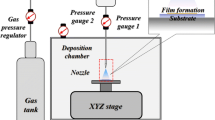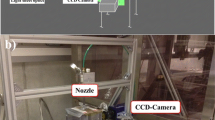Abstract
A nanoparticle virtual impactor was constructed and its performance under different operating conditions was investigated. Experimental evaluations showed that the nanoparticle virtual impactor has a 50% cutoff size ranging from 15 to 60nm. Further, the cutoff size of 60nm can be achieved at an impactor chamber pressure of 220torr when the nozzle upstream pressure is 760torr. This pressure level is much higher than that of thin-plate orifice nozzle impactors, which require 12torr to achieve the cutoff size of 66nm. Thus, the proposed virtual impactor can be operated with a small vacuum pump, which is more preferable for practical applications.
In this study, the effects of design parameters on the impactor performance have also been experimentally investigated. The parameters include the separation distance between the collection probe and the acceleration nozzle, the pressure ratio of the upstream and downstream chambers, the diameter ratio of the collection probe and the nozzle, the flow ratio of the minor and total flows, total mass flow rates and the upstream pressure. The experimental data obtained were then scaled with the Stokes number defined by previous researchers. The performance of the proposed nanoparticle virtual impactors can therefore be estimated when the operating variables are given or measured. An important finding in this parametric study is that the optimal diameter ratio of collection probe to nozzle is around 1.8. It is different from the value of 1.4 recommended in previous studies with virtual impactors for submicron particle applications.
Similar content being viewed by others
References
Anderson J.D.J., 1990. Modern Compressible Flow with Historical Perspective, McGraw Hill.
Biswas P. & R.C. Flagan, 1984. High-velocity inertial impactors. Environ. Sci. Technol. 18, 611–616.
Biswas P. & R.C. Flagan, 1988. The Particle Trap Impactor. J. Aerosol. Sci. 19, 113–121.
Chen Da-Ren & D.Y.H. Pui, 1997. Numerical modeling of the performance of differential mobility analyzers for nanometer aerosol measurements. J. Aerosol Sci. 28(4), 985–1004.
Chen Da-Ren, D.Y.H. Pui, D. Hummes, H. Fissan, F.R. Quant, et al., 1998. Design and evaluation of a nanometer aerosol differential mobility analyzer (Nano-DMA). J. Aesosol Sci. 29(5/6), 497–509.
Chutmanop J., N. Uji, M. Furuuchi & C. Kanaoka, 2000. Inertial Classification of Ultra Fine Particle by a Supersonic Virutal Impactor. The 17th Symposium on Aerosol Science & Technology, Higashi-Hiroshima, Japan, Japan Association of Aerosol Science and Technology.
Ding Y. & P. Koutrakis, 2000. Development of a dichotomous slit nozzle virtual impactor. J. Aerosol Sci. 31(12), 1421–1431.
Fernández de la Mora J., S.V. Hering, N. Rao & P.H. McMurry, 1990a. Hypersonic impaction on ultrafine particle. J. Aerosol Sci. 21(2), 169–187.
Fernández de la Mora J., N. Rao & P.H. McMurry, 1990b. Inertial impaction of fine particles at moderate Reynolds numbers and in the transonic regime with a thin-plate orifice nozzle. J. Aerosol Sci. 21(5), 889–909.
Flagan R.C., 1982. Compressible flowinertial impactor. J. Colloid Interface Sci. 87(1), 291–297.
Foelsch K., 1949. The analytical design of an axially symmetric Laval nozzle for a parallel and uniform jet. J. Aeronautical Sci. 16(3): 161–167.
Forney L.J., D.G. Ravenhall & S.S. Lee, 1982. Experimental and theoretical study of a two-dimensional virtual impactor. Environ. Sci. Technol. 16, 492–497.
Furuuchi, 2001. Numerical Simulation of Flow and Particle Motion Inside a Supersoic Virtual Impactor, NSF-ESF International Symposium on Nanoparticle: Aerosols and Materials, 98-101, Pusan, Korea, July 5-6, 2001.
Gomez-Moreno F.J., J. Rosell-Llompart & J. Fernandez de la Mora, 2002. Turbulent transition in impactor jets and its effects on impactor resolution. J. Aerosol Sci. 33, 459–476.
Hering S.W., 1987. Calibration of the QCM impactor for stratospheric Sampling. Aerosol Sci. Technol. 7, 257–274.
Hering S.V. & S.K. Friedlander, 1979. Design and evaluation of a new low-pressure impactor. 2. Environ. Sci. Technol. 13(2), 184–188.
Hillamo R.E. & E.I. Kauppinen, 1991. On the performance of the Berner lowpressure impactor. Aerosol Sci. Technol. 14, 33–47.
Kanaoka C. & M. Furuuchi, 1996. Inertial separation of nanosize particles from supersonic flow field. J. Aerosol Sci. 27, S.5623–S.5624.
Kauppinen E.I. & R.E. Hillamo, 1989. Modification of the University ofWashington Mark 5 in-stack impactor. J. Aerosol Sci. 20(5), 813–827.
Liu B.Y.H. & D.Y.H. Pui, 1974. A submicron aerosol standard and the primary, absolute calibration of the condensation nuclei counter. J. Colloid Interface Sci. 47(1), 155–171.
Loo B.W. & C.P. Cork, 1988. Development of high efficiency virtual impactor. Aerosol Sci. Technol. 9, 167–176.
Mader B.T., R.C. Flagan & J.H. Seinfeld, 2001. Sampling atmospheric carbonaceous aerosols using a particle trap impactor/denuder sampler. Evniron. Sci. Technol. 35, 4857–4867.
Maple V.A. & C.M. Chien, 1980. Virtual impactors: A theoretical study. Environ. Sci. Technol. 14, 976–985.
Marple V.A., K.L. Rubow & S.M. Behm, 1991. A micro-orifice uniform deposit impactor (MOUDI): Description, calibration, and use. Aerosol Sci. Technol. 14, 434–446.
Rader & V.A. Marple, 1985. Effect of ultra-Stokesian drag and particle interception on impaction characteristics. Aerosol. Sci. Technol. 4, 141–156.
Tsai C.-J. & T.-Y. Lin, 2000. Particle collection efficiency of different impactor designs. Separation Sci. Technol. 35(16), 2639–2650.
Author information
Authors and Affiliations
Rights and permissions
About this article
Cite this article
Lee, P., Chen, DR. & Pui, D.Y. Experimental Study of a Nanoparticle Virtual Impactor. Journal of Nanoparticle Research 5, 269–280 (2003). https://doi.org/10.1023/A:1025538930994
Issue Date:
DOI: https://doi.org/10.1023/A:1025538930994




